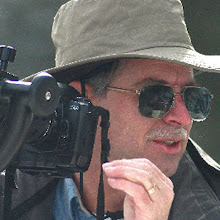Lunar Eclipse, Garden of the Gods Park - Sheila and I spent the better part of the night last night (and this morning!) photographing the total lunar eclipse. It was fascinating to watch the full moon with its bright light casting shadows around us, with near full visibility...to near total darkness, in a matter of several minutes. I had set up two cameras - one with a 300 mm / f2.8 (and 1.4X teleconverter) on my Canon T2i body, in order to obtain close-ups of the moon itself. The other one was set up in a fixed location near the Tower of Babel rock formation, hooked up to an intervelometer shutter release, set to fire every 8.5 minutes. The primary purpose of this one was to capture a sequence of moon shots, which would later be combined into a single frame showing the moon at different stages of eclipse. The 8.5 minutes was calculated such that none of the moon images would overlap. The tripod was located such that the sequence would have arced directly over the rocks.
This is one frame from that sequence, showing the moon as its just coming out of umbral stage. The slight sliver of crescent moon is causing a "starburst" effect, which I thought was unique. This was photographed using my Canon 5D with 24 to 70 mm /f2.8 lens (adjusted to 30 mm) and set to ISO 800, 30 second exposure at f5.6. It was slightly adjusted with Lightroom to bring up the shadow detail in the rocks. I also applied sharpening and noise reduction to clean up the sky. Because of the 30 second exposure, if one were to magnify this image, you'd be able to see slight arcs in the stars, due to the earth's rotation. The light on the rocks is from the natural ambient light from the nearby building in the main parking lot where we were located.
Note that focussing any lens at night (especially during a total eclipse) is troublesome. If your camera body has a "live view" mode (or equivalent), where you can see the actual image via the LCD screen, it's possible to set focus on bright objects, such as the moon or stars. You'll want to switch to Manual focus, so that successive shots don't end up defocussing the lens. For camera bodies without "live view", it's tougher. It's generally best to prefocus the lens during the day or early evening, switch to Manual focus and tape the adjusting ring down with gaffers tape. This assumes there will be no drastic temperature changes, as this can affect the focus point (mainly on large telephotos). For these lunar shots, I set the exposure to Manual and diddle around until I get proper exposure for the moon. To see stars well, you'll want to set the aperture for around f4 to f5.6 and the ISO to a setting where they start to show well in the LCD screen. The shutter speed should be 15 to 30 seconds for good detail. If you're fortunate enough to have some foreground, it can be light-painted with a strong flashlight during the exposure.






Using "live view" is a great idea, but where I live the moon was almost directly overhead with no angle to be had. I had to nearly lie down on the ground to see if I even had the moon in my frame while the camera was on the tripod. Quite the acrobatics act in the cold! Was it not directly overhead where you were shooting from? I'm curious now as I only live about 25-30 minutes from Garden of the Gods where you were at!
ReplyDeleteHi Kim,
ReplyDeleteIt was definitely a tough shoot with the moon nearly straight up. I did have to go through some contortions to see through the one camera with the telephoto! The other camera has a means to attach a right-angle viewer to the eyepiece and I was wishing it had fit on the T2i body!